The Intel Core i7-12700K and Core i5-12600K Review: High Performance For the Mid-Range
by Gavin Bonshor on March 29, 2022 8:00 AM ESTCPU Benchmark Performance: Encoding and Compression
One of the interesting elements on modern processors is encoding performance. This covers two main areas: encryption/decryption for secure data transfer, and video transcoding from one video format to another.
In the encrypt/decrypt scenario, how data is transferred and by what mechanism is pertinent to on-the-fly encryption of sensitive data - a process by which more modern devices are leaning to for software security.
Video transcoding as a tool to adjust the quality, file size and resolution of a video file has boomed in recent years, such as providing the optimum video for devices before consumption, or for game streamers who are wanting to upload the output from their video camera in real-time. As we move into live 3D video, this task will only get more strenuous, and it turns out that the performance of certain algorithms is a function of the input/output of the content.
We are using DDR5 memory at the following settings:
- DDR5-4800(B) CL40
Encoding
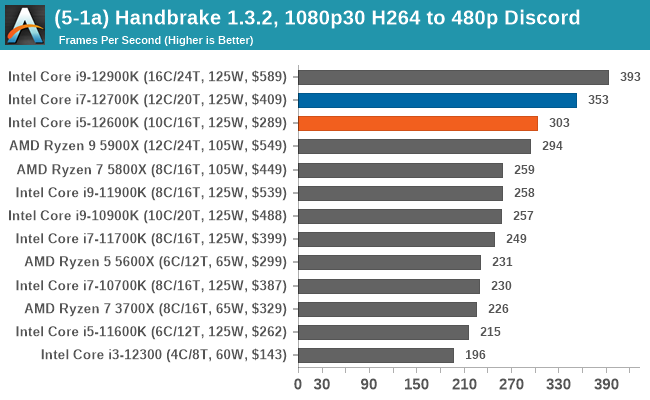
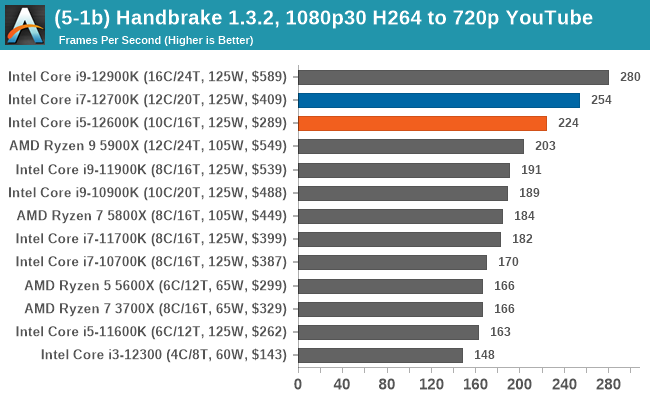
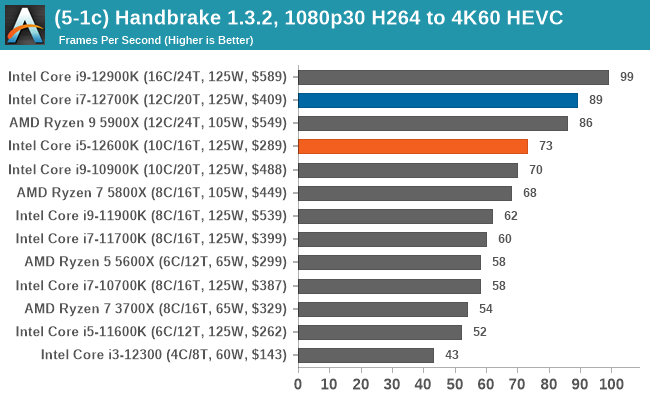
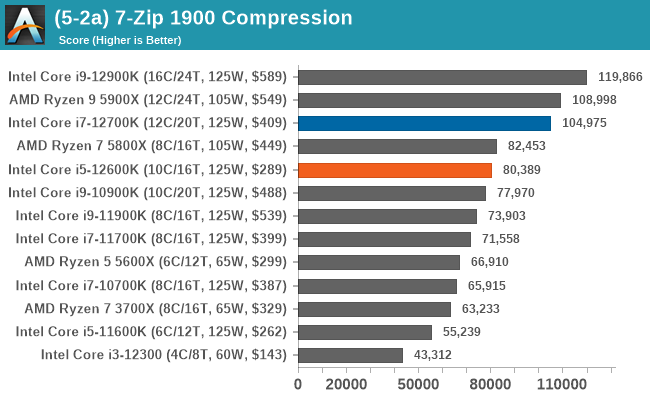
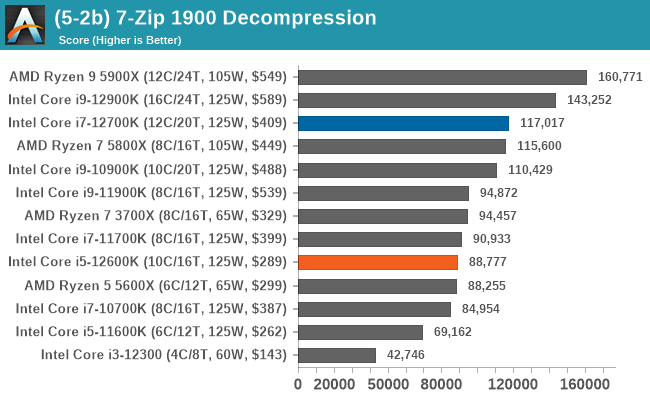
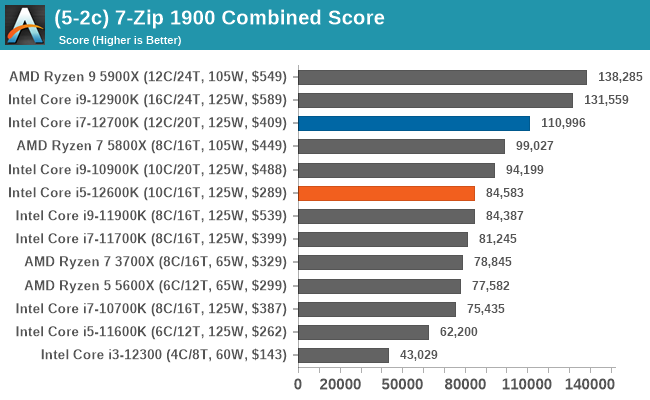
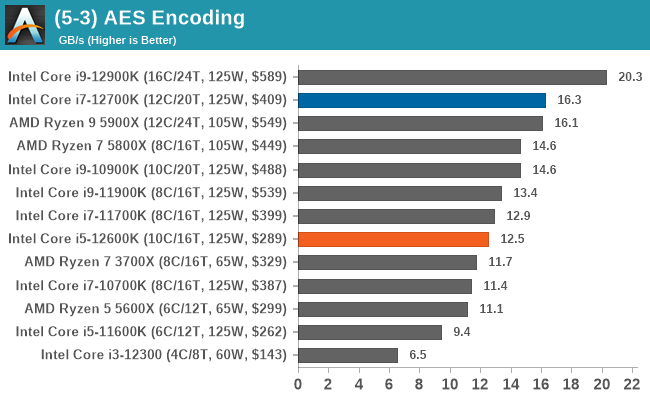
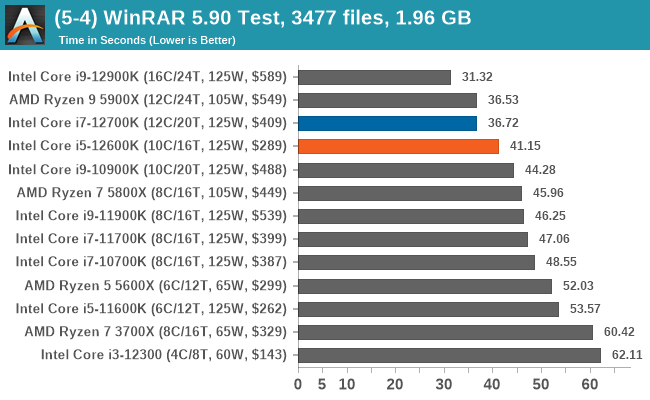
In terms of encoding and compression, Intel's 12th Gen Core gains some wins, but AMD's Ryzen 5000 also wins. It's a very competitive segment, but in the case of the Core i7-12700K and Core i5-12600K, both remain competitive against the competition.










196 Comments
View All Comments
mode_13h - Thursday, March 31, 2022 - link
Somewhat off-topic: the top of my page is serving me an from ASML, indicating they're seeking optical engineers to work on EUV.Crazy. You'd think it would be a dream job for anyone with the proper skillset, but I guess their growth is outpacing the available talent pool.
Well, if anyone reading this thread knows an optical engineer, you might tell them to go have a look at ASML. I didn't check to see whether relocation would be necessary, but perhaps that's the catch.
mode_13h - Thursday, March 31, 2022 - link
"... serving me an ad from ASML, ...", I meant to say.milli - Thursday, March 31, 2022 - link
Peak power consumption is handy data but not very useful by itself.How about average power consumption during applications / games / ...
You also used to represent power consumption to complete a task, now that was useful data.
eloyard - Thursday, March 31, 2022 - link
Peak power is essential for understanding how robust power delivery system and heat sink need to be."Average is the only important thing" is typical Intel's bs pushing cost of more expensive components different than processor (mobo, psu, cooler) to the consumer.
mode_13h - Friday, April 1, 2022 - link
> Peak power is essential for understanding how robust power delivery system and heat sink need to be.Yes and no. It really depends on the minimum duration over which a "peak" is defined. If we're talking about a couple milliseconds, then absolutely not. If we're talking about a couple seconds, then yes.
> "Average is the only important thing" is typical Intel's bs ...
I understand your point, but it's still relevant for people trying to determine which CPU will deliver the most performance per unit of energy. With increasing energy prices and the warmer months approaching those of us in the northern hemisphere, that's not merely a theoretical concern.
milli - Friday, April 1, 2022 - link
Your post oozes fanboism.Firstly, I didn't dismiss peak power consumption (as you assume) but by itself it's useless. The graph doesn't even state how long it's holding this peak power consumption.
Secondly, where do I say "Average is the only important thing". Right, nowhere.
But if a CPU peaks 200W for 1s and then goes to 65W, I would like to know that. That's important data. It's data that Anandtech used to provide but stopped doing.
Mike Bruzzone - Thursday, March 31, 2022 - link
A look at Alder Lake Production data;i9s = 55.01% of all Alder Lake with 12900K @ 43.56% and KF @ 2.07% and 900 @ 8.92%
i7s = 34% of Alder Lake with 12700K @ 29.42% and KF @ 3.82%
i5s = 9.3% with 600K @ 3.13%, 600KF @ 1.5% and 400 @ 2.63%
i3s = 1.13% with no SKU greater than 1% of full line volume.
Pentium = 0.08%
Celeron = 0.45%
Alder Lake full line can be characterized, essentially, all i9 12900K and i7 12700K and remainder fall out from sort. Similar Coffee Refresh where most of full line volume are disabled i9s. Cores disablement is discouraged on industrial management best practice subject manufacturing cost optimization not incorporating the added production step to purposely disable that at bottom bin can drive cost > price, despite most bottom bin given away anyway cost : price averaged across the total sales package.
Analyst suspects OEM volume procurement price for Alder mirroring exactly the category percent supply is range $254 to $239 each per i9/i7 component calculated $1K Average Weighed Price of i9/i7 category / 2 and that all i5/i3/P&C are thrown in for free as sales package 'close' incentive.
Net cost of Alder at $1K AWP < Cost of Sales, < Cost of R&D, < Tax Accrual = $214.
Average Marginal Cost of production = $63.34 per component
Average Marginal Cost of fabrication = $25.88 per component
Mike Bruzzone, Camp Marketing
Mike Bruzzone - Thursday, March 31, 2022 - link
Adding on Alder, there are supposedly two mask sets. The first a 215 mm2 full P+E and the other a cost optimized for area 116 mm2 P only. Not much has been said can anyone confirm these two mask sets and die area?mb
dwade123 - Thursday, March 31, 2022 - link
Already sold my 5800x for a 12900k. I will never buy AMD again and forced to beta test their crap for them for free.mode_13h - Friday, April 1, 2022 - link
> I will never buy AMD againAMD is still growing and maturing. With that, their quality control should hopefully improve.
About 11 years ago, Intel suffered a similarly embarrassing problem, with the SATA controller in their Sandybridge motherboard chipsets. Had you forsworn never to buy Intel again, you now be up a creek without a paddle.
https://www.anandtech.com/show/4142/intel-discover...